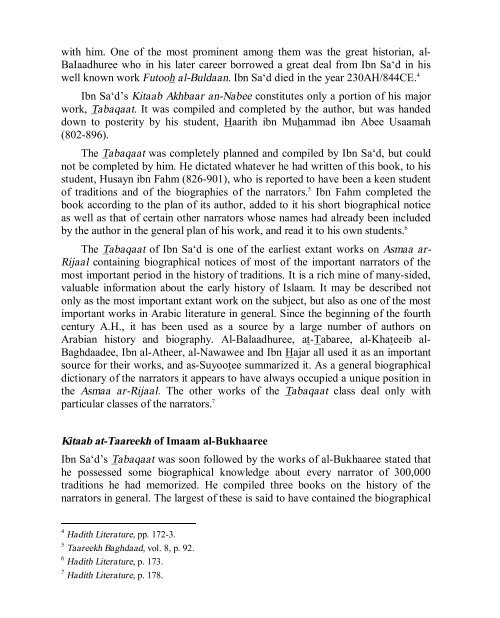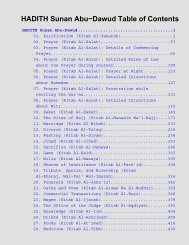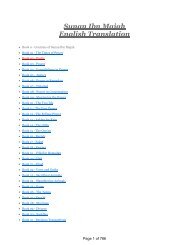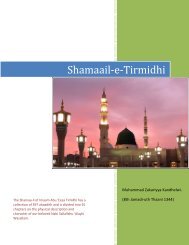with him. One of the most prominent among them was the great historian, <strong>al</strong>-BaIaadhuree who in his later career borrowed a great de<strong>al</strong> from Ibn Sa‘d in hiswell known work Futooh <strong>al</strong>-Buldaan. Ibn Sa‘d died in the year 230AH/844CE. 4Ibn Sa‘d’s Kitaab Akhbaar an-Nabee constitutes only a portion of his majorwork, Tabaqaat. It was compiled and completed by the author, but was handeddown to posterity by his student, Haarith ibn Muhammad ibn Abee Usaamah(802-896).The Tabaqaat was completely planned and compiled by Ibn Sa‘d, but couldnot be completed by him. He dictated whatever he had written of this book, to hisstudent, Husayn ibn Fahm (826-901), who is reported to have been a keen studentof traditions and of the biographies of the narrators. 5 Ibn Fahm completed thebook according to the plan of its author, added to it his short biographic<strong>al</strong> noticeas well as that of certain other narrators whose names had <strong>al</strong>ready been includedby the author in the gener<strong>al</strong> plan of his work, and read it to his own students. 6The Tabaqaat of Ibn Sa‘d is one of the earliest extant works on Asmaa ar-Rija<strong>al</strong> containing biographic<strong>al</strong> notices of most of the important narrators of themost important period in the history of traditions. It is a rich mine of many-sided,v<strong>al</strong>uable information about the early history of Islaam. It may be described notonly as the most important extant work on the subject, but <strong>al</strong>so as one of the mostimportant works in Arabic literature in gener<strong>al</strong>. Since the beginning of the fourthcentury A.H., it has been used as a source by a large number of authors onArabian history and biography. Al-B<strong>al</strong>aadhuree, at-Tabaree, <strong>al</strong>-Khateeib <strong>al</strong>-Baghdaadee, Ibn <strong>al</strong>-Atheer, <strong>al</strong>-Nawawee and Ibn Hajar <strong>al</strong>l used it as an importantsource for their works, and as-Suyootee summarized it. As a gener<strong>al</strong> biographic<strong>al</strong>dictionary of the narrators it appears to have <strong>al</strong>ways occupied a unique position inthe Asmaa ar-Rija<strong>al</strong>. The other works of the Tabaqaat class de<strong>al</strong> only withparticular classes of the narrators. 7Kitaab at-Taareekh of Imaam <strong>al</strong>-BukhaareeIbn Sa‘d’s Tabaqaat was soon followed by the works of <strong>al</strong>-Bukhaaree stated thathe possessed some biographic<strong>al</strong> knowledge about every narrator of 300,000traditions he had memorized. He compiled three books on the history of thenarrators in gener<strong>al</strong>. The largest of these is said to have contained the biographic<strong>al</strong>4 <strong>Hadith</strong> Literature, pp. 172-3.5 Taareekh Baghdaad, vol. 8, p. 92.6 <strong>Hadith</strong> Literature, p. 173.7 <strong>Hadith</strong> Literature, p. 178.
notices of more than 40,000 narrators. But no complete manuscript of the book isknown to exist. Only various parts of it are preserved in certain libraries on thebasis of which the Daa’irat <strong>al</strong>-Ma‘aarif, Hyderabad (India) has prepared a text ofthe book, and published it.2. Speci<strong>al</strong> Works. By speci<strong>al</strong> works is meant works dedicated to particulargroups, backgrounds or eras of narrators. These speci<strong>al</strong>ized biographic<strong>al</strong>dictionaries of narrators developed <strong>al</strong>most simultaneously with the gener<strong>al</strong>biographic<strong>al</strong> dictionariesThe most important of them are: a) those containing the biographies of theCompanions; b) those containing the biographies of the narrators who lived in orvisited any particular town or province; c) and those containing the biographies ofthe narrators belonging to the various schools of the jurists.A. Biographic<strong>al</strong> Dictionaries of the CompanionsThese constitute the vit<strong>al</strong> part of the Asmaa ar-Rija<strong>al</strong>, however, no independentbook on the subject appears to have been written before the third century of theHijrah, when the great traditionist, <strong>al</strong>-Bukhaaree, compiled the first independentbiographic<strong>al</strong> dictionary of the Companions which must have been mainly basedon: (a) the Seerah literature; (b) the numerous monographs relating to the variousimportant events during the early period of the history of Islaam; (c) a largenumber of traditions containing biographic<strong>al</strong> materi<strong>al</strong> relating to the Companions,and the earlier gener<strong>al</strong> works on the Asmaa ar-Rija<strong>al</strong>.Al-Bukhaaree was followed by numerous authors during the subsequentperiods in the history of Islaam, who produced a vast literature on the subject.Aboo Ya‘laa Ahmad ibn ‘Alee (201-307/816-919), Abul-Qaasim ‘Abdullaah <strong>al</strong>-Baghawee (828-929), the great traditionist and copyist, Aboo Hafs ‘Umar ibnAhmad (commonly known as Ibn Shahin, 909-995), one of the most prolificwriters of his time (who spent more than 700 dirhams on ink only), Aboo‘Abdullaah Muhammad ibn Yahyaa ibn Manda (d. 301/913), Aboo Nu‘aymAhmad ibn ‘Abdillaah (947-1012), who has been described as one of the besttraditionists, Ibn ‘Abdil-Barr (978-1070) of Cordova, a contemporary of <strong>al</strong>-Kahateeb <strong>al</strong>-Baghdaadee, and the greatest traditionist of his time in the West,Aboo Moosaa Muhammad ibn Abee Bakr (501-581/1107-1185), and many othersproduced an extensive literature on the biographies of the Companions. 88 <strong>Hadith</strong> Literature, pp. 178-80.
- Page 2:
[Usool Al Hadeeth]The Methodology o
- Page 6 and 7:
from the Prophet of his actions, sa
- Page 8 and 9:
3. LawsOne of the primary duties of
- Page 10 and 11:
authentically attributable to the P
- Page 12 and 13:
was asked which city will be conque
- Page 14 and 15:
Rahmaan, who was at that time the m
- Page 16 and 17:
centuries. They also grouped the ha
- Page 18 and 19:
Prophet's lifetime, and in the wars
- Page 20 and 21:
JAABIR IBN ‘ABDILLAAH. One of the
- Page 22 and 23:
2. ‘Ard : Reading by the Students
- Page 24 and 25:
Transmission TerminologyThe hadeeth
- Page 26 and 27:
EVOLUTION OF THE SANADTeaching the
- Page 28 and 29:
the Sahaabah had left off and began
- Page 30 and 31:
In this case the Sanad is shorter b
- Page 32 and 33:
The Pattern of IsnaadThe usual patt
- Page 35 and 36:
Origins of the Isnaad SystemEvery t
- Page 37 and 38:
FOUR: ClassificationDue to a variet
- Page 39 and 40:
Hadeeth SaheehA hadeeth must meet t
- Page 41 and 42:
Saheeh li GhayrihThe hadeeth saheeh
- Page 43 and 44:
ecorded by others.5. Authentic hade
- Page 45 and 46:
Abee Awfaa wrote to him saying that
- Page 47 and 48:
Muhammad ibn Bashshaar informed us
- Page 49 and 50:
Ruling on Da‘eef NarrationsSchola
- Page 51 and 52:
In this narration, he deleted the c
- Page 53 and 54:
called Taghleeq at-Ta‘leeq (Closi
- Page 55 and 56:
The jurists (fuqahaa) generally def
- Page 57 and 58:
Caesar’s emissary collected by Ah
- Page 59 and 60:
Muwatta 42 with the following chain
- Page 61 and 62:
Saqiyah called him Aboo Wahb al-Asa
- Page 63 and 64:
Khateeb al-Baghdaadee’s book call
- Page 65 and 66:
The Mu’annan is a hadeeth in whic
- Page 67 and 68:
and the household of the Prophet (r
- Page 69 and 70:
The supporters of each opinion fabr
- Page 71 and 72:
(Soorah al-Israa, 17: 79) he said t
- Page 73 and 74:
7. Inventions for Personal Motives:
- Page 75 and 76:
Zamakhasharee and ash-Shawkaanee.Li
- Page 77 and 78:
definitions by other scholars are:1
- Page 79 and 80:
FIVE: ConflictIn vast number of nar
- Page 81 and 82:
farewell Hajj as well as on other o
- Page 83 and 84:
caught) but on the fourth occasion
- Page 85 and 86:
hadeeth narrations. So much so that
- Page 87 and 88:
Mulaykah, 14 az-Zuhree 15 and Shu
- Page 89 and 90:
them in ash-Sha‘bee’s direction
- Page 91 and 92: ased on the relative reliability of
- Page 93 and 94: Step Four: The eras of the narrator
- Page 95 and 96: ) متواتِر بِال ْمعن
- Page 97 and 98: have even claimed Ijmaa‘ (unanimi
- Page 99 and 100: What further explains this Qur’aa
- Page 101 and 102: Bukhaaree - the most correct book a
- Page 103 and 104: 3. ‘Abdullaah ibn ‘Umar said:
- Page 105 and 106: of scholars. It is false because it
- Page 107 and 108: This hadeeth was narrated from Anas
- Page 109 and 110: the view that discrepancies between
- Page 111 and 112: EIGHT: LiteratureThe origins of the
- Page 113 and 114: collected hadeeths which were relat
- Page 115 and 116: Ibn Hambal began lecturing on tradi
- Page 117 and 118: students, and also to his sons and
- Page 119 and 120: The final chapter is on Shamaa’il
- Page 121 and 122: On many occasions al-Bukhaaree’s
- Page 123 and 124: Saheeh of Muslim ibn al-Hajjaaj ibn
- Page 125 and 126: have examined 500,000 hadeeths, and
- Page 127 and 128: Islamic world. 43 Sunan Abee Daawoo
- Page 129 and 130: them on account of its isnaad. I he
- Page 131 and 132: Muslim. 56 The book does, however,
- Page 133 and 134: Ad-Daaraqutnee rapidly acquired a s
- Page 135 and 136: men had to be appointed to repeat h
- Page 137 and 138: The Zawaa’id Work of al-Haythamee
- Page 139 and 140: (iv) They had been used as a basis
- Page 141: the well-known Kitaab al-Ansaab of
- Page 145 and 146: Zaynud-Deen al-‘Iraaqee (725-806/
- Page 147 and 148: forced to leave the city and wander
- Page 149 and 150: the author. But the work could not
- Page 151 and 152: TEN: Women Scholars of HadeethHisto
- Page 153 and 154: daughter of the distinguished juris
- Page 155 and 156: turn lectured to many students, som
- Page 157 and 158: excelled in the art of calligraphy
- Page 159 and 160: occurs only in Mutayyin’s narrati
- Page 161 and 162: Abu Bakr as-Siddeeq, then to Ali ib
- Page 163 and 164: ف َأ َمسك َها ف َل
- Page 165 and 166: Haakim, Muhammad ibn ‘Abdillaah a
- Page 167: Thahabee, Muhammad ibn Ahmad ath-.





